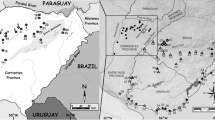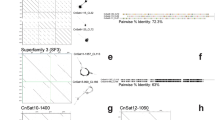Abstract
A chromosome 1 (Cr1) pericentric inversion is described in six of seven species in the genus Ctenomys (tuco-tucos) from Uruguay. The inversion was inferred from G-band analyses of subtelocentric Cr1 hypothesised to be derived from the ancestral metacentric condition. Cr1 varies across species in heterochromatin amount and localisation including a metacentric chromosome without positive C-bands in C. torquatus, a subtelocentric chromosome with heterochromatic short arms in C. rionegrensis, and a subtelocentric chromosome negative after C-banding in five of the species analysed here. Pachytene chromosomes from C. rionegrensis, a species with the highest heterochromatin content, and C. torquatus, one of the species with the lowest heterochromatin content, were analysed in order to assess possible mechanisms of heterochromatin evolution. This analysis revealed the presence of three heterochromatic chromocenters in C. rionegrensis where bivalents converge, while in C. torquatus only one chromocenter was observed. In both species, highly repetitive DNA was observed, localised in chromocenters after “in situ” hybridisation. Heterochromatin associated protein M31 was localised in chromocenters of both species after immuno-detection. The spread of heterochromatin in Ctenomys chromosomes could be produced by chromatin exchanges at the chromocenter level. We propose the exchange of this DNA associated proteins between non-homologous chromosomes in pachytene to be the responsible for the spread of heterochromatin through the karyotypes of species like C. rionegrensis
Similar content being viewed by others
References
C. Altuna A. Novello E.P. Lessa (1985) ArticleTitleNotas sobre la morfología espermática de Ctenomys rionegrensis (Rodentia Octodontidae) del Uruguay Brenesia 24 397–401
Cook, J.A., S. Anderson & T.L. Yates, 1990. Notes on Bolivian mammals 6. The genus Ctenomys (Rodentia Ctenomidae) in the highlands. Amer. Mus. Novitates 2980: 20–27, Cytogenet. Cell Genet. 67: 193–198
Dover, G., S. Brown, E. Coen, J. Dallas, T. Strachan & M. Trick, 1982. The dynamics of genome evolution and species differentiation, pp. 343–372 in Genome Evolution edited by G. Dover & R.B. Flavell. Academic Press.
D.J. Driscoll G.C. Palmer A. Melman (1979) ArticleTitleNonhomologous associations of C-heterochromatin at human male meitoic prophase Cytogenet. Cell Genet. 23 23–32 Occurrence Handle761482 Occurrence Handle1:STN:280:CSaC3cnkslE%3D
R. Feito M. Gallardo (1982) ArticleTitleSperm morphology of the Chilean species of Ctenomys (Octodontidae) J. Mammal. 63 658–661
T.R.O. Freitas (1994) ArticleTitleGeographical variation of heterochromatin in Ctenomys flamarioni (Rodentia Octodontidae) and its cytogenetic relationships with other species of the genus Cytogenet. Cell Genet. 67 193–198 Occurrence Handle8062596
T.R.O. Freitas E.P. Lessa (1984) ArticleTitleCytogenetics and morphology of Ctenomys torquatus (Rodentia Octodontidae) J. Mammal. 65 637–642
M. Gallardo (1979) ArticleTitleLas especies chilenas de Ctenomys (Rodentia Octodontidae) I Estabilidad cariotípica Arch. Biol. Med. Exp. 12 71–82
M. Gallardo (1991) ArticleTitleKaryotypic evolution in Ctenomys (Rodentia Octodontidae) J. Mammal. 72 11–21
M.R. Lee F.F. Elder (1988) ArticleTitleYeast stimulation of bone marrow mitoses for cytogenetic investigation Cytogenet. Cell Genet. 26 36–40
E.P. Lessa J.A. Cook (1998) ArticleTitleThe molecular phylogenetics of tuco-tucos (genus Ctenomys, Rodentia: Octodontidae) suggests an early burst of speciation Mol. Phylogen. Evol. 9 89–99
A. Massarini M.A. Barros M.O. Ortells O.A. Reig (1991) ArticleTitleEvolutionary biology of fossorial ctenomyne rodents (Caviomorph Octodontidae). I. Chromosomal polymorphism and small karyotypic differentiation in Central Argentinian populations of tuco-tucos Genetica 83 131–144 Occurrence Handle10.1007/BF00058530
A.F. Novello E.P. Lessa (1986) ArticleTitleG-band homology in two karyomorphs of the Ctenomys pearsoni complex (Rodentia Octodontidae) of neotropical fossorial rodents Z. Säugetierkunde 51 378–380
Novello, A., N. Brum-Zorrilla, H. Musto, H. Bruzzoni & M. Stoll, 1988. Cromosomas y caracterización del ADN de Ctenomys pearsoni (Rodentia Octodontidae). Montevideo, Uruguay: V Reunión Iberoamericana de Conservación y Zoología de Vertebrados
A. Novello E.P. Lessa C. Sambarino S. Monzón (1990) ArticleTitleChromosomal variation in two populations of the genus Ctenomys (Rodentia Octodontidae) from Uruguay Z. Säugetierkunde 55 43–48
A. Novello M.N. Cortinas M. Suarez H. Musto (1996) ArticleTitleCytogenetic and molecular analysis of the satellite DNA of the genus Ctenomys (Rodentia Octodontidae) from Uruguay Chromosome Res. 4 335–339 Occurrence Handle8871821 Occurrence Handle1:CAS:528:DyaK28Xlt1Kns7o%3D Occurrence Handle10.1007/BF02257268
A. Novello C.A. Altuna (2002) ArticleTitleCytogenetics and distribution of two new karyomorphs of the Ctenomys pearsoni complex (Rodentia, Octodontidae) from southern Uruguay Mamm. biol. 67 188–192
M.O. Ortells (1995) ArticleTitlePhylogenetic analysis of G-banded karyotypes among the South American subterranean rodents of the genus Ctenomys (Caviomorpha: Octodontidae), with special reference to chromosomal evolution and speciation Biol. J. Linn. Soc. 54 43–70 Occurrence Handle10.1016/0024-4066(95)90036-5
A.G.E. Pearse (1968) Histochemistry EditionNumber2 Churchill Livingstone London 427
O.A. Reig C. Bush M.O. Ortells J.R. Contreras (1990 ) An overview of evolution, systematics, population biology, cytogenetics, molecular biology and speciation in Ctenomys E. Nevo O.A. Reig (Eds) Evolution of Subterranean Mammals at the Organismal and Molecular Levels Alan R Liss 71–96
O.A. Reig P. Kiblisky (1969) ArticleTitleChromosome multiformity in the genus Ctenomys (Rodentia Octodontidae). A progress report Chromosoma 28 211–244 Occurrence Handle4904544 Occurrence Handle1:STN:280:CS%2BC3c%2FisVM%3D Occurrence Handle10.1007/BF00331531
M.S. Rossi O.A. Reig J. Zorzopulos (1990) ArticleTitleEvidence for rolling-circle replication in a major satellite DNA from the South American rodents of the genus Ctenomys Mol. Biol. Evol. 7 340–350 Occurrence Handle1974692 Occurrence Handle1:CAS:528:DyaK3cXltFSgsro%3D
M.S. Rossi C.A. Redi G. Viale A.I. Massarini E. Capanna (1995) ArticleTitleChromosomal distribution of the major satellite DNA of South American rodents of the genus Ctenomys Cytogenet. Cell Genet. 69 179–184 Occurrence Handle7698006 Occurrence Handle1:STN:280:ByqB3M3hsFQ%3D
L.A. Ruedas J.A. Cook J.W. Yates (1992) ArticleTitleComparative genome size and rapid chromosomal evolution in the South American tuco-tucos (Rodentia: Ctenomydae) Genome 36 449–458
H. Saumweber (1987) Arrangement of chromosomes in interphase cell nuclei W. Henning (Eds) Results and Problems in Cell Differentiation 14, Structure and Function of Eukaryotic Chromosomes Springer-Verlag Berlin 227–234
T. Schwarzacher J.S. Heslop-Harrison (2000) Practical In␣Situ Hybridization Bios Scientific Press UK 203
D. Schweizer L. Loidl B. Hamilton (1987 ) Heterochromatin and the phenomenon of chromosome banding W. Hennig (Eds) in Results and Problems in Cell Differentiation 14, Structure and Function of Eukaryotic Chromosomes Springer-Verlag Berlin 235–254
P. Singh J. Ross J. Pearce R. Khotary R. Burton R. Paro T.C. James S.J. Gaunt (1991) ArticleTitleA sequence motif found in a Drosophila heterochromatin protein is conserved in animals and plants Nucleic Acids Res. 19 789–794 Occurrence Handle1708124 Occurrence Handle1:CAS:528:DyaK3MXlsFaitLY%3D
C.H. Slamovits M.S. Rossi (2002) ArticleTitleSatellite DNA: agent of chromosomal evolution in mammals. A review J. Neotrop. Mammal. 9 297–308
A.T. Sumner (1972) ArticleTitleA simple technique for demonstrating centromeric heterochromatin Exp. Cell Res. 75 304–306 Occurrence Handle4117921 Occurrence Handle1:STN:280:CSyD2cjltFI%3D Occurrence Handle10.1016/0014-4827(72)90558-7
M. Switonsky I. Gustavsson (1991) ArticleTitleCentric-fusion translocation and whole-arm heterochromatin in the karyotype of the blue fox (Alopex lagopus L.): synaptonemal complex analysis Cytogenet. Cell Genet. 57 1–8 Occurrence Handle10.1016/0165-4608(91)90183-U
K.A. Weggrett P.S. Hill F. James A. Hutchings G.W. Butcher P. Singh (1994) ArticleTitleA mammalian homologue of Drosophila heterochromatin 1 (HP1) is a component of constitutive heterochromatin Cytogenet. Cell Genet. 66 99–103 Occurrence Handle10.1159/000133676
Author information
Authors and Affiliations
Corresponding author
Rights and permissions
About this article
Cite this article
Novello, A., Villar, S. Chromosome plasticity in Ctenomys (Rodentia Octodontidae): chromosome 1 evolution and heterochromatin variation. Genetica 127, 303–309 (2006). https://doi.org/10.1007/s10709-005-5048-6
Received:
Accepted:
Issue Date:
DOI: https://doi.org/10.1007/s10709-005-5048-6




